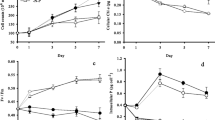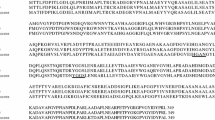Abstract
Objective
To investigate whether genes other than the operons nahAaAbAcAdBFCED and nahGTHINLOMKJ of Pseudomonas putida are involved in the tolerance of the bacterium to naphthalene.
Results
Cellular responses of P. putida ND6 grown with 2 and 4 g naphthalene/l were investigated using a quantitative proteomic-based approach. Comparative analysis of the proteome data identified that the expression levels of 22 proteins involved in heat shock and universal stress response, naphthalene degradation, cell envelope synthesis, and motility were up-regulated; while the expression levels of 26 proteins involved in protein and fatty acid synthesis, carbon compound, nucleotide, and amino acid metabolism, and small molecule transport were down-regulated.
Conclusion
Our findings offer insights into the cellular response of P. putida to high naphthalene concentrations at the protein level.

Similar content being viewed by others
References
Bell A, Hancock RE (1989) Outer membrane protein H1 of Pseudomonas aeruginosa: purification of the protein and cloning and nucleotide sequence of the gene. J Bacteriol 171:3211–3217
Benndorf D, Thiersch M, Loffhagen N, Kunath C, Harms H (2006) Pseudomonas putida KT2440 responds specifically to chlorophenoxy herbicides and their initial metabolites. Proteomics 6:3319–3329
Brandt U (2006) Energy converting NADH: quinone oxidoreductase (complex I). Annu Rev Biochem 75:69–92
Cao B, Loh KC (2008) Catabolic pathways and cellular responses of Pseudomonas putida P8 during growth on benzoate with a proteomics approach. Biotechnol Bioeng 101:1297–1312
Gago G, Diacovich L, Arabolaza A, Tsai SC, Gramajo H (2011) Fatty acid biosynthesis in actinomycetes. FEMS Microbiol Rev 35:475–497
Jaeger T, Budde H, Flohé L, Menge U, Singh M, Trujillo M, Radi R (2004) Multiple thioredoxin-mediated routes to detoxify hydroperoxides in Mycobacterium tuberculosis. Arch Biochem Biophys 423:182–191
Kim YH, Cho K, Yun SH, Kim JY, Kwon KH, Yoo JS, Kim SI (2006) Analysis of aromatic catabolic pathways in Pseudomonas putida KT 2440 using a combined proteomic approach: 2-DE/MS and cleavable isotope-coded affinity tag analysis. Proteomics 6:1301–1318
Kumari P, Kant S, Zaman S, Mahapatro GK, Banerjee N, Sarin NB (2014) A novel insecticidal GroEL protein from Xenorhabdus nematophila confers insect resistance in tobacco. Transgenic Res 23:99–107
Kurbatov L, Albrecht D, Herrmann H, Petruschka L (2006) Analysis of the proteome of Pseudomonas putida KT2440 grown on different sources of carbon and energy. Environ Microbiol 8:466–478
Lee S, Jeon E, Jung Y, Lee J (2012) Heterologous co-expression of accA, fabD, and thioesterase genes for improving long-chain fatty acid production in Pseudomonas aeruginosa and Escherichia coli. Appl Biochem Biotechnol 167:24–38
Li W, Shi J, Wang X, Han Y, Tong W, Ma L, Liu B, Cai B (2004) Complete nucleotide sequence and organization of the naphthalene catabolic plasmid pND6-1 from Pseudomonas sp. strain ND6. Gene 336:231–240
Li S, Li X, Zhao H, Cai B (2011) Physiological role of the novel salicylaldehyde dehydrogenase NahV in mineralization of naphthalene by Pseudomonas putida ND6. Microbiol Res 166:643–653
Li S, Zhao H, Li Y, Niu S, Cai B (2012) Complete genome sequence of the naphthalene-degrading Pseudomonas putida strain ND6. J Bacteriol 194:5154–5155
Li S, Zhao H, Li Y, Niu S, Cai B (2013) Complete nucleotide sequence of plasmid pND6-2 from Pseudomonas putida ND6 and characterization of conjugative genes. Gene 512:148–156
Loh KC, Cao B (2008) Paradigm in biodegradation using Pseudomonas putida—a review of proteomics studies. Enzyme Microb Technol 43:1–12
Manara A, DalCorso G, Baliardini C, Farinati S, Cecconi D, Furini A (2012) Pseudomonas putida response to cadmium: changes in membrane and cytosolic proteomes. J Proteome Res 11:4169–4179
Marco-Marin C, Gil-Ortiz F, Rubio V (2005) The crystal structure of Pyrococcus furiosus UMP kinase provides insight into catalysis and regulation in microbial pyrimidine nucleotide biosynthesis. J Mol Biol 352:438–454
Mathews II, Kappock TJ, Stubbe J, Ealick SE (1999) Crystal structure of Escherichia coli PurE, an unusual mutase in the purine biosynthetic pathway. Structure 7:1395–1406
Meyer E, Kappock TJ, Osuji C, Stubbe J (1999) Evidence for the direct transfer of the carboxylate of N5-carboxyaminoimidazole ribonucleotide (N5-CAIR) to generate 4-carboxy-5-aminoimidazole ribonucleotide catalyzed by Escherichia coli PurE, an N5-CAIR mutase. Biochemistry 38:3012–3018
Meyer Y, Buchanan BB, Vignols F, Reichheld JP (2009) Thioredoxins and glutaredoxins: unifying elements in redox biology. Annu Rev Genet 43:335–367
Pumphrey GM, Madsen EL (2007) Naphthalene metabolism and growth inhibition by naphthalene in Polaromonas naphthalenivorans strain CJ2. Microbiology 153:3730–3738
Ray P, Girard V, Gault M, Job C, Bonneu M, Mandrand-Berthelot MA, Singh SS, Job D, Rodrigue A (2013) Pseudomonas putida KT2440 response to nickel or cobalt induced stress by quantitative proteomics. Metallomics 5:68–79
Santos PM, Benndorf D, Sá-Correia I (2004) Insights into Pseudomonas putida KT2440 response to phenol-induced stress by quantitative proteomics. Proteomics 4:2640–2652
Symmons MF, Jones GH, Luisi BF (2000) A duplicated fold is the structural basis for polynucleotide phosphorylase catalytic activity, processivity, and regulation. Structure 8:1215–1226
Tamber S, Ochs MM, Hancock RE (2006) Role of the novel OprD family of porins in nutrient uptake in Pseudomonas aeruginosa. J Bacteriol 188:45–54
Yun SH, Kim YH, Joo EJ, Choi JS, Sohn JH, Kim SI (2006) Proteome analysis of cellular response of Pseudomonas putida KT2440 to tetracycline stress. Curr Microbiol 53:95–101
Zhao H, Chen D, Li Y, Cai B (2005) Overexpression, purification and characterization of a new salicylate hydroxylase from naphthalene-degrading Pseudomonas sp. strain ND6. Microbiol Res 160:307–313
Acknowledgments
This work was financially supported by the National Natural Science Foundation of China (Nos. 21037002 and 21477163) and the Tianjin Research Program of Application Foundation and Advanced Technology (No. 14JCZDJC40400).
Author information
Authors and Affiliations
Corresponding author
Rights and permissions
About this article
Cite this article
Li, SS., Hu, X., Zhao, H. et al. Quantitative analysis of cellular proteome alterations of Pseudomonas putida to naphthalene-induced stress. Biotechnol Lett 37, 1645–1654 (2015). https://doi.org/10.1007/s10529-015-1828-y
Received:
Accepted:
Published:
Issue Date:
DOI: https://doi.org/10.1007/s10529-015-1828-y




